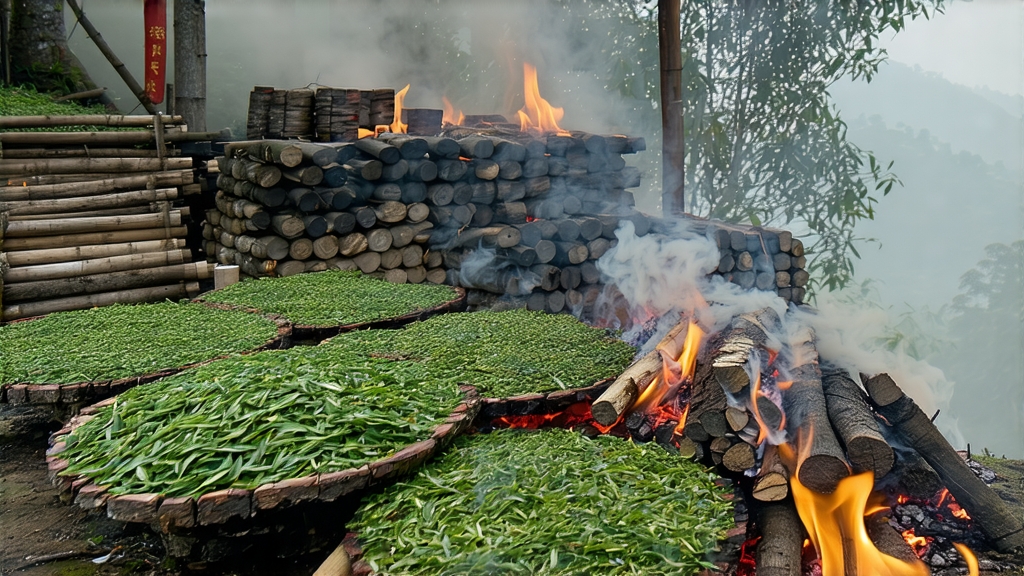
When European tea clippers first rounded the Cape of Good Hope in the late seventeenth century, the holds of the East Indiamen carried a strange new leaf that the Chinese called “bohea.” That leaf—small, wiry, and perfumed with the scent of pine and longan—would soon conquer London coffee-houses, inspire duchesses to trade porcelain for stoneware, and, in the eyes of many historians, birth the very category we now label “black tea.” Its name on the wharf was Lapsang Souchong, and every later black tea—Keemun, Assam, Ceylon, even Darjeeling—owes its existence to the smoking sheds hidden in the crevices of the Wuyi massif in northern Fujian.
Geography and cultivar
The Wuyi Mountains rise like a granite fortress out of subtropical jungle, their cliffs pocketed with narrow gorges that trap morning fog and reflect sunlight onto terraces no wider than a single row of bushes. Only three tiny villages—Tongmu, Guadun, and Miaowan—sit high enough inside the 60,000-hectare UNESCO reserve to produce the authentic leaf. Here the original cultivar, Xiao Ye Zhong (“small-leaf species”), grows slowly on mineral-rich, weathered igneous soil, developing a low yield but extraordinary concentration of polyphenols and volatile aromatics. Attempts to transplant the same cultivar to lower elevations or neighboring counties produce a tea that lacks the tell-tale camphor note, proving that terroir is as inseparable from Lapsang Souchong as slate is from Chablis.
Two families, not one
International markets often treat “Lapsang” as a single style, yet within Tongmu the craft is split into two distinct genealogies. The traditional, or “craft,” Souchong (zhengshan xiaozhong) is withered over gentle embers of local Masson pine; no other wood is permitted, and the fire is never allowed to flame. The leaf absorbs only the aromatic volatiles—guaiacol and syringol—while the smoke itself is kept at a distance. The result is a cup that is resinous yet sweet, with hints of dried longan, sandalwood, and cooling camphor. The second style, exported since the Qing dynasty for Russian and British trade, is the “commodity” version: leaves are dried directly above roaring pine logs, acquiring an aggressive, tarry punch that can feel like licking a campfire. Knowing which style sits in the tin is the first step toward a respectful brew.
Pluck and wither: the silent choreography
Authentic Souchong is harvested only for a few days around the Qingming festival, when two leaves and a bud are still tight and silvery. The pluckers work before 10 a.m., laying the shoots into shallow bamboo baskets lined with hemp cloth to prevent bruising. Back in the village, the leaves are spread on wooden racks inside a second-floor loft whose shutters are opened or closed with the instinct of a sailor trimming sails. For fourteen to eighteen hours the leaf loses moisture, but more importantly its cell walls begin to fracture, allowing oxidative enzymes to meet ambient oxygen. Because the Wuyi spring is cool and humid, withering can last until 2 a.m.; masters gauge readiness not by clock but by the change in sound: when a handful of leaf is shaken, it must rustle like a lizard darting through dry grass.
Rolling, oxidation, and the moment of smoke
Once supple, the leaf is rolled under a pressure of precisely 6 kilograms per square centimeter—enough to rupture 80 % of the cells without breaking the wiry shape. Oxidation follows in cedar-lined trays, where the leaf gradually turns from jade to copper while releasing a scent of peach skin and magnolia. At 85 % oxidation the master inserts a pivotal pause: he lifts the trays into the smoking shed, a dark pagoda-like structure whose floor is a lattice over pine embers. Here the leaf does not dry; it merely inhales. Thirty minutes later it is removed, allowed to rest, then returned for a final, longer exposure. This stop-start ritual—unique in all tea making—prevents the smoke from masking the tea’s innate honeyed sweetness.
Charcoal finishing and the art of “lao huo”
The last stage employs no smoke at all